2017 NISSAN ROGUE HYBRID wheel
[x] Cancel search: wheelPage 490 of 520

10 Technical and consumer information
Recommended fluids/lubricants and capacities......10-2
Fuel recommendation .......................... 10-3
Engine oil and oil filter recommendations .........10-6
Air conditioner system refrigerant and oil
recommendations ............................. 10-7
Specifications .................................... 10-8
Engine ....................................... 10-8
Wheels and tires .............................. 10-9
Dimensions and weights .......................10-9
When traveling or registering in another country .....10-10
Vehicle identification ............................. 10-10
Vehicle identification number (VIN) plate ........10-10
Vehicle identification number
(chassis number) ............................. 10-10
Engine serial number .......................... 10-11
F.M.V.S.S./C.M.V.S.S. certification label .........10-11
Emission control information label ..............10-11
Tire and Loading Information label ..............10-12
Air conditioner specification label ...............10-12Installing front license plate
.......................10-12
Vehicle loading information .......................10-13
Terms ....................................... 10-13
Vehicle load capacity ......................... 10-14
Securing the load ............................. 10-15
Loading tips ................................. 10-16
Measurement of weights ......................10-16
Towing a trailer .................................. 10-17
Flat towing for All–Wheel drive vehicle
(if so equipped) .............................. 10-17
Flat towing for front wheel drive vehicle
(if so equipped) .............................. 10-17
Uniform tire quality grading .......................10-18
Emission control system warranty .................10-18
Reporting safety defects ......................... 10-19
Readiness for inspection/maintenance (I/M) test ....10-20
Event Data Recorders (EDR) ......................10-20
Owner’s Manual/Service Manual order information . .10-21
Page 498 of 520
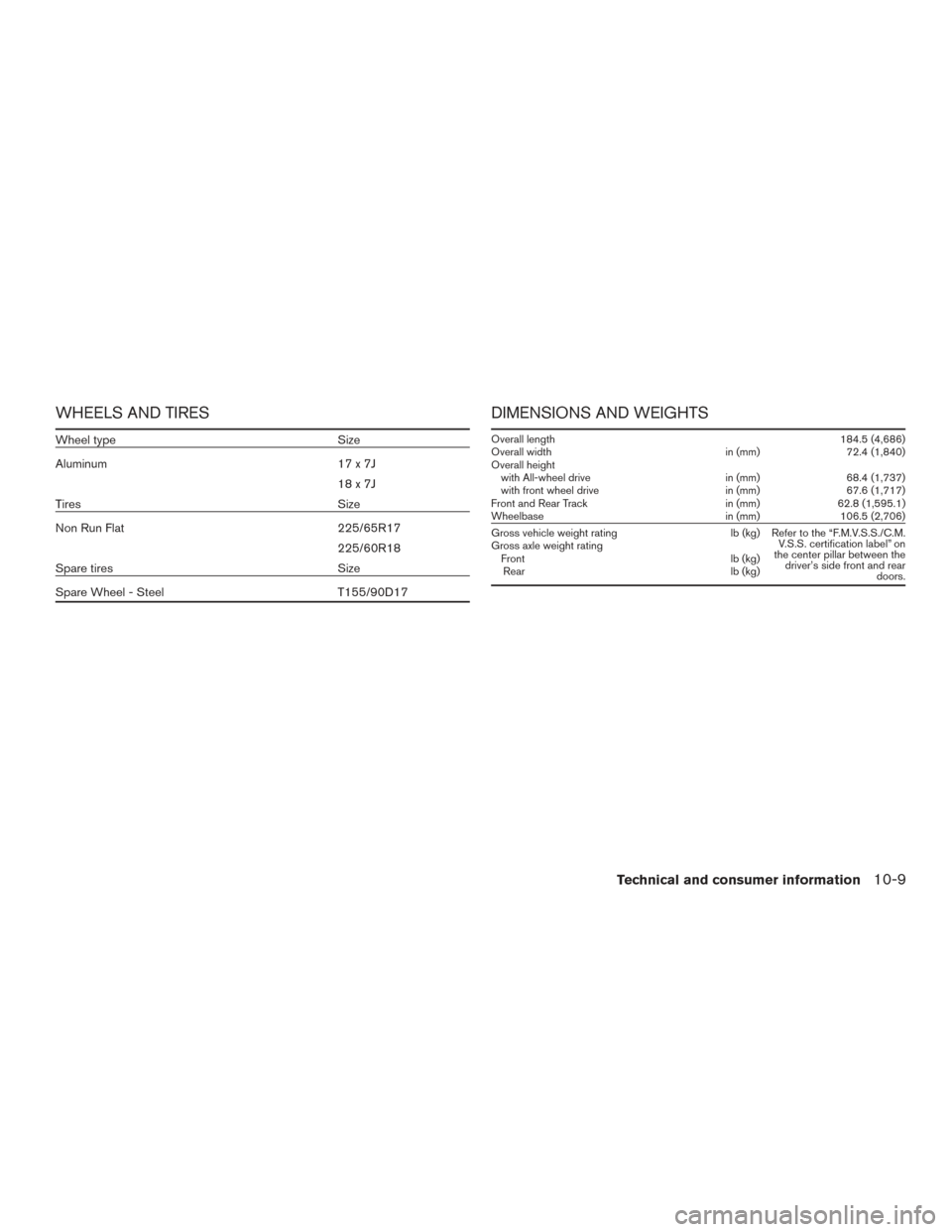
WHEELS AND TIRES
Wheel typeSize
Aluminum 17 x 7J
18x7J
Tires Size
Non Run Flat 225/65R17
225/60R18
Spare tires Size
Spare Wheel - Steel T155/90D17
DIMENSIONS AND WEIGHTS
Overall length 184.5 (4,686)
Overall width in (mm)72.4 (1,840)
Overall height with All-wheel drive in (mm)68.4 (1,737)
with front wheel drive in (mm)67.6 (1,717)
Front and Rear Track in (mm)62.8 (1,595.1)
Wheelbase in (mm)106.5 (2,706)
Gross vehicle weight rating lb (kg) Refer to the “F.M.V.S.S./C.M.
V.S.S. certification label” on
the center pillar between the driver’s side front and rear doors.
Gross axle weight rating
Front lb (kg)
Rear lb (kg)
Technical and consumer information10-9
Page 505 of 520
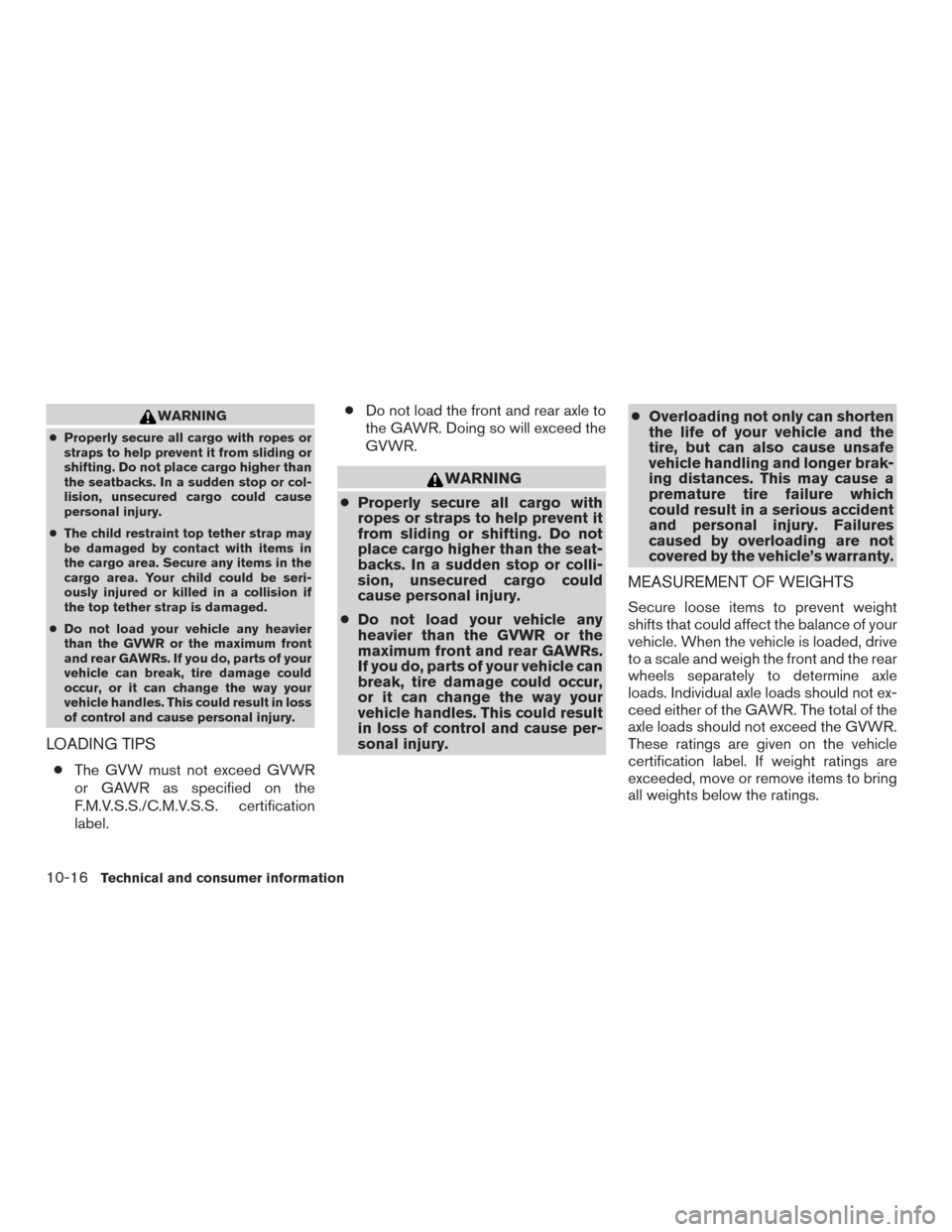
WARNING
●Properly secure all cargo with ropes or
straps to help prevent it from sliding or
shifting. Do not place cargo higher than
the seatbacks. In a sudden stop or col-
lision, unsecured cargo could cause
personal injury.
● The child restraint top tether strap may
be damaged by contact with items in
the cargo area. Secure any items in the
cargo area. Your child could be seri-
ously injured or killed in a collision if
the top tether strap is damaged.
● Do not load your vehicle any heavier
than the GVWR or the maximum front
and rear GAWRs. If you do, parts of your
vehicle can break, tire damage could
occur, or it can change the way your
vehicle handles. This could result in loss
of control and cause personal injury.
LOADING TIPS
● The GVW must not exceed GVWR
or GAWR as specified on the
F.M.V.S.S./C.M.V.S.S. certification
label. ●
Do not load the front and rear axle to
the GAWR. Doing so will exceed the
GVWR.
WARNING
● Properly secure all cargo with
ropes or straps to help prevent it
from sliding or shifting. Do not
place cargo higher than the seat-
backs. In a sudden stop or colli-
sion, unsecured cargo could
cause personal injury.
● Do not load your vehicle any
heavier than the GVWR or the
maximum front and rear GAWRs.
If you do, parts of your vehicle can
break, tire damage could occur,
or it can change the way your
vehicle handles. This could result
in loss of control and cause per-
sonal injury. ●
Overloading not only can shorten
the life of your vehicle and the
tire, but can also cause unsafe
vehicle handling and longer brak-
ing distances. This may cause a
premature tire failure which
could result in a serious accident
and personal injury. Failures
caused by overloading are not
covered by the vehicle’s warranty.
MEASUREMENT OF WEIGHTS
Secure loose items to prevent weight
shifts that could affect the balance of your
vehicle. When the vehicle is loaded, drive
to a scale and weigh the front and the rear
wheels separately to determine axle
loads. Individual axle loads should not ex-
ceed either of the GAWR. The total of the
axle loads should not exceed the GVWR.
These ratings are given on the vehicle
certification label. If weight ratings are
exceeded, move or remove items to bring
all weights below the ratings.
10-16
Technical and consumer information
Page 506 of 520
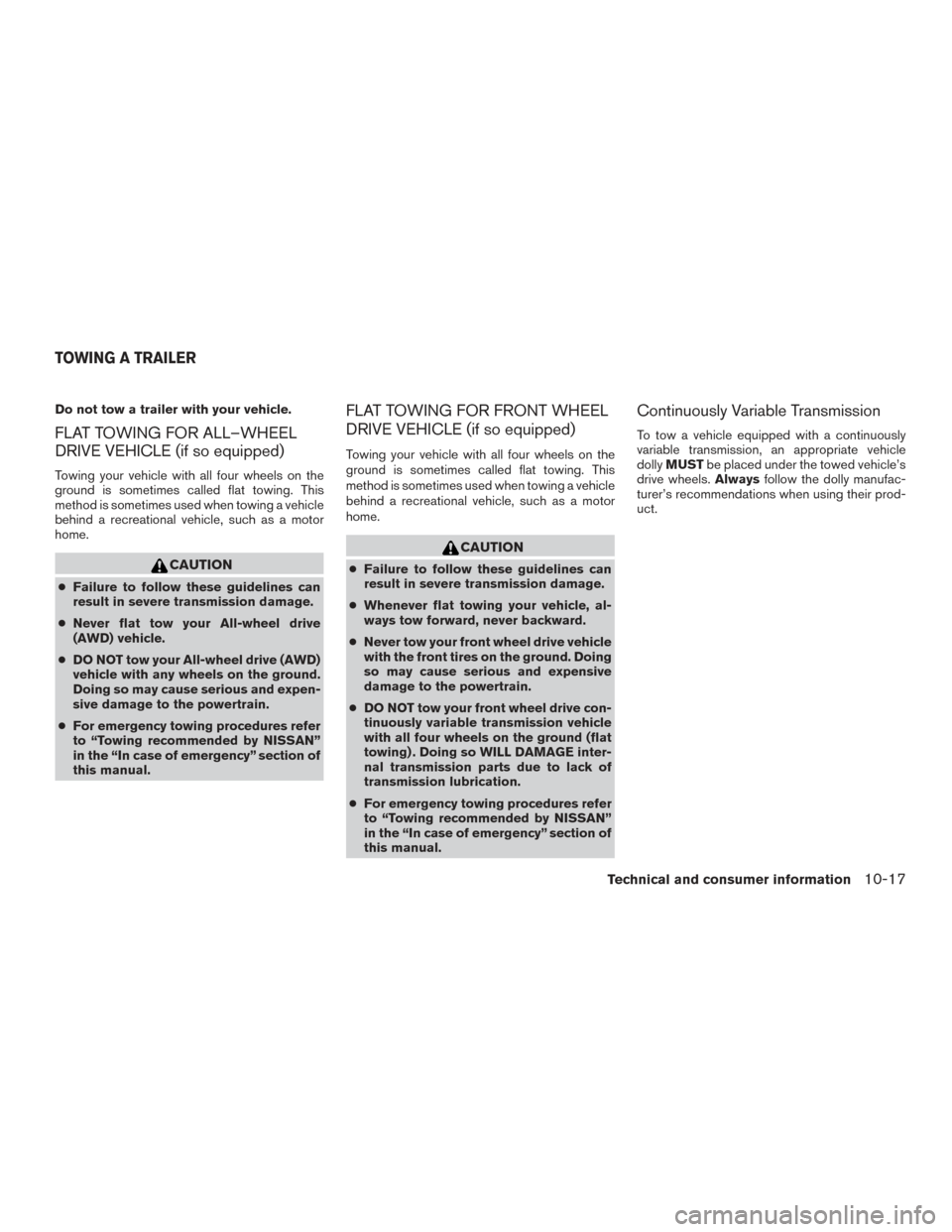
Do not tow a trailer with your vehicle.
FLAT TOWING FOR ALL–WHEEL
DRIVE VEHICLE (if so equipped)
Towing your vehicle with all four wheels on the
ground is sometimes called flat towing. This
method is sometimes used when towing a vehicle
behind a recreational vehicle, such as a motor
home.
CAUTION
●Failure to follow these guidelines can
result in severe transmission damage.
● Never flat tow your All-wheel drive
(AWD) vehicle.
● DO NOT tow your All-wheel drive (AWD)
vehicle with any wheels on the ground.
Doing so may cause serious and expen-
sive damage to the powertrain.
● For emergency towing procedures refer
to “Towing recommended by NISSAN”
in the “In case of emergency” section of
this manual.
FLAT TOWING FOR FRONT WHEEL
DRIVE VEHICLE (if so equipped)
Towing your vehicle with all four wheels on the
ground is sometimes called flat towing. This
method is sometimes used when towing a vehicle
behind a recreational vehicle, such as a motor
home.
CAUTION
●Failure to follow these guidelines can
result in severe transmission damage.
● Whenever flat towing your vehicle, al-
ways tow forward, never backward.
● Never tow your front wheel drive vehicle
with the front tires on the ground. Doing
so may cause serious and expensive
damage to the powertrain.
● DO NOT tow your front wheel drive con-
tinuously variable transmission vehicle
with all four wheels on the ground (flat
towing) . Doing so WILL DAMAGE inter-
nal transmission parts due to lack of
transmission lubrication.
● For emergency towing procedures refer
to “Towing recommended by NISSAN”
in the “In case of emergency” section of
this manual.
Continuously Variable Transmission
To tow a vehicle equipped with a continuously
variable transmission, an appropriate vehicle
dolly MUST be placed under the towed vehicle’s
drive wheels. Alwaysfollow the dolly manufac-
turer’s recommendations when using their prod-
uct.
TOWING A TRAILER
Technical and consumer information10-17
Page 507 of 520
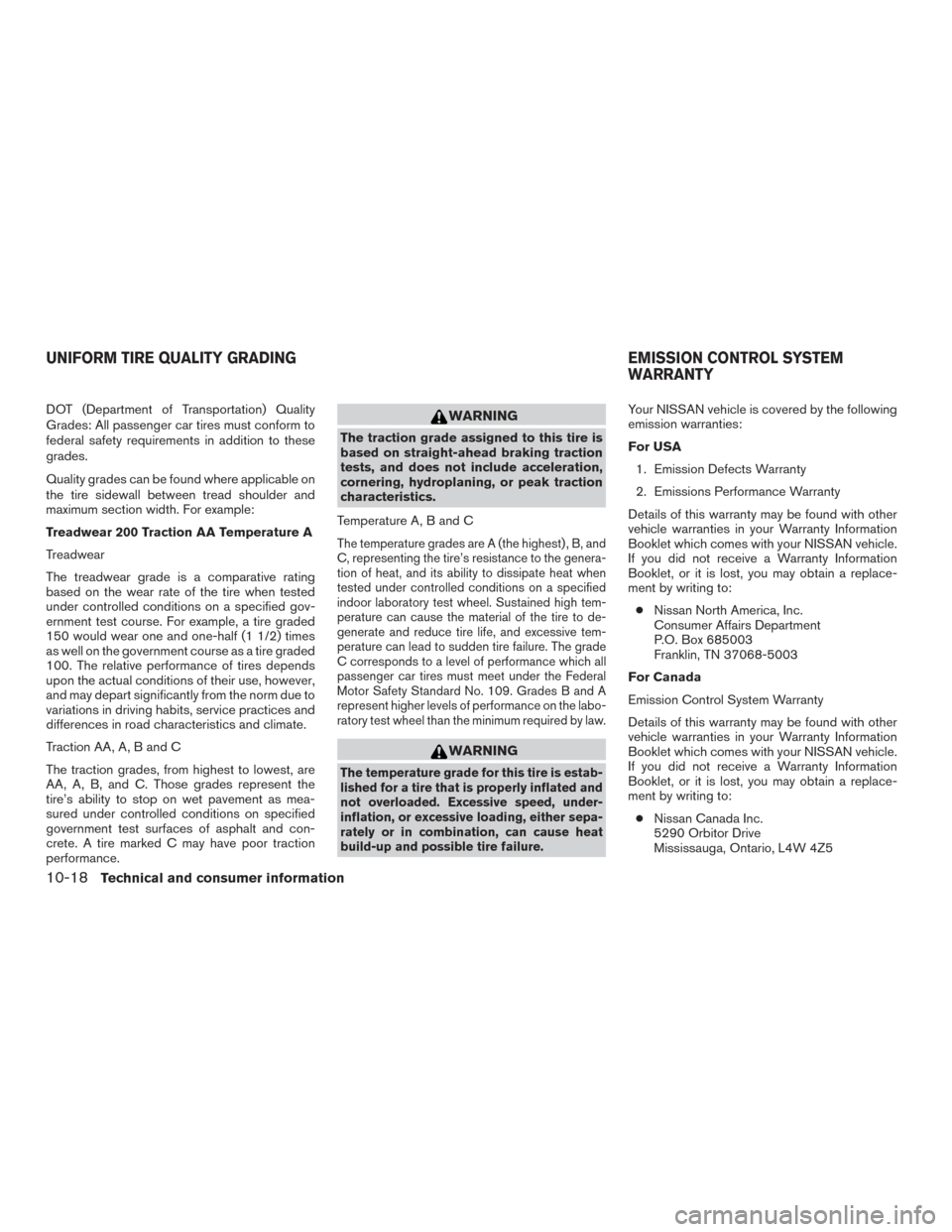
DOT (Department of Transportation) Quality
Grades: All passenger car tires must conform to
federal safety requirements in addition to these
grades.
Quality grades can be found where applicable on
the tire sidewall between tread shoulder and
maximum section width. For example:
Treadwear 200 Traction AA Temperature A
Treadwear
The treadwear grade is a comparative rating
based on the wear rate of the tire when tested
under controlled conditions on a specified gov-
ernment test course. For example, a tire graded
150 would wear one and one-half (1 1/2) times
as well on the government course as a tire graded
100. The relative performance of tires depends
upon the actual conditions of their use, however,
and may depart significantly from the norm due to
variations in driving habits, service practices and
differences in road characteristics and climate.
Traction AA, A, B and C
The traction grades, from highest to lowest, are
AA, A, B, and C. Those grades represent the
tire’s ability to stop on wet pavement as mea-
sured under controlled conditions on specified
government test surfaces of asphalt and con-
crete. A tire marked C may have poor traction
performance.WARNING
The traction grade assigned to this tire is
based on straight-ahead braking traction
tests, and does not include acceleration,
cornering, hydroplaning, or peak traction
characteristics.
Temperature A, B and C
The temperature grades are A (the highest) , B, and
C, representing the tire’s resistance to the genera-
tion of heat, and its ability to dissipate heat when
tested under controlled conditions on a specified
indoor laboratory test wheel. Sustained high tem-
perature can cause the material of the tire to de-
generate and reduce tire life, and excessive tem-
perature can lead to sudden tire failure. The grade
C corresponds to a level of performance which all
passenger car tires must meet under the Federal
Motor Safety Standard No. 109. Grades B and A
represent higher levels of performance on the labo-
ratory test wheel than the minimum required by law.
WARNING
The temperature grade for this tire is estab-
lished for a tire that is properly inflated and
not overloaded. Excessive speed, under-
inflation, or excessive loading, either sepa-
rately or in combination, can cause heat
build-up and possible tire failure.
Your NISSAN vehicle is covered by the following
emission warranties:
For USA 1. Emission Defects Warranty
2. Emissions Performance Warranty
Details of this warranty may be found with other
vehicle warranties in your Warranty Information
Booklet which comes with your NISSAN vehicle.
If you did not receive a Warranty Information
Booklet, or it is lost, you may obtain a replace-
ment by writing to: ● Nissan North America, Inc.
Consumer Affairs Department
P.O. Box 685003
Franklin, TN 37068-5003
For Canada
Emission Control System Warranty
Details of this warranty may be found with other
vehicle warranties in your Warranty Information
Booklet which comes with your NISSAN vehicle.
If you did not receive a Warranty Information
Booklet, or it is lost, you may obtain a replace-
ment by writing to: ● Nissan Canada Inc.
5290 Orbitor Drive
Mississauga, Ontario, L4W 4Z5
UNIFORM TIRE QUALITY GRADING EMISSION CONTROL SYSTEM
WARRANTY
10-18Technical and consumer information
Page 509 of 520
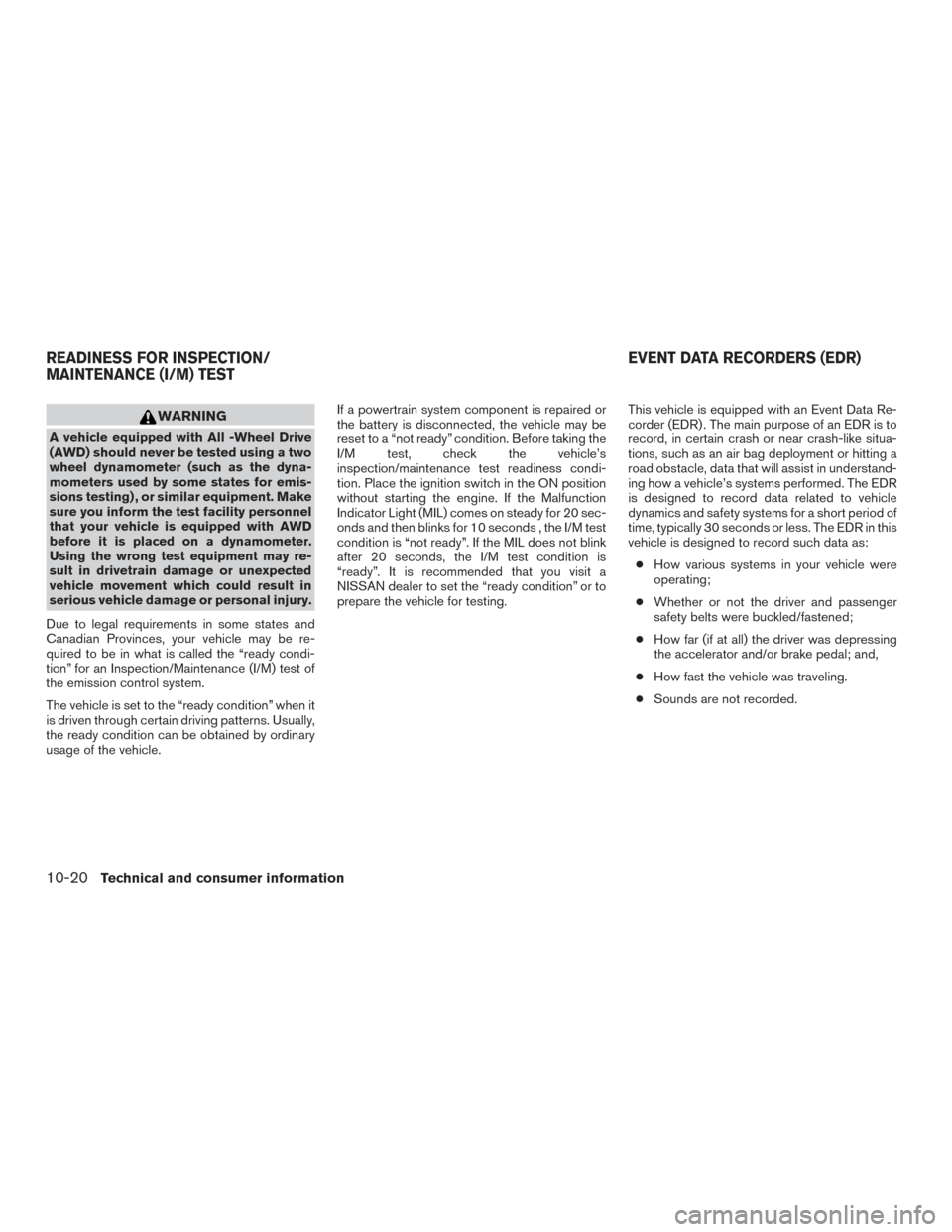
WARNING
A vehicle equipped with All -Wheel Drive
(AWD) should never be tested using a two
wheel dynamometer (such as the dyna-
mometers used by some states for emis-
sions testing) , or similar equipment. Make
sure you inform the test facility personnel
that your vehicle is equipped with AWD
before it is placed on a dynamometer.
Using the wrong test equipment may re-
sult in drivetrain damage or unexpected
vehicle movement which could result in
serious vehicle damage or personal injury.
Due to legal requirements in some states and
Canadian Provinces, your vehicle may be re-
quired to be in what is called the “ready condi-
tion” for an Inspection/Maintenance (I/M) test of
the emission control system.
The vehicle is set to the “ready condition” when it
is driven through certain driving patterns. Usually,
the ready condition can be obtained by ordinary
usage of the vehicle. If a powertrain system component is repaired or
the battery is disconnected, the vehicle may be
reset to a “not ready” condition. Before taking the
I/M test, check the vehicle’s
inspection/maintenance test readiness condi-
tion. Place the ignition switch in the ON position
without starting the engine. If the Malfunction
Indicator Light (MIL) comes on steady for 20 sec-
onds and then blinks for 10 seconds , the I/M test
condition is “not ready”. If the MIL does not blink
after 20 seconds, the I/M test condition is
“ready”. It is recommended that you visit a
NISSAN dealer to set the “ready condition” or to
prepare the vehicle for testing.
This vehicle is equipped with an Event Data Re-
corder (EDR) . The main purpose of an EDR is to
record, in certain crash or near crash-like situa-
tions, such as an air bag deployment or hitting a
road obstacle, data that will assist in understand-
ing how a vehicle’s systems performed. The EDR
is designed to record data related to vehicle
dynamics and safety systems for a short period of
time, typically 30 seconds or less. The EDR in this
vehicle is designed to record such data as:
● How various systems in your vehicle were
operating;
● Whether or not the driver and passenger
safety belts were buckled/fastened;
● How far (if at all) the driver was depressing
the accelerator and/or brake pedal; and,
● How fast the vehicle was traveling.
● Sounds are not recorded.
READINESS FOR INSPECTION/
MAINTENANCE (I/M) TEST EVENT DATA RECORDERS (EDR)
10-20Technical and consumer information
Page 512 of 520
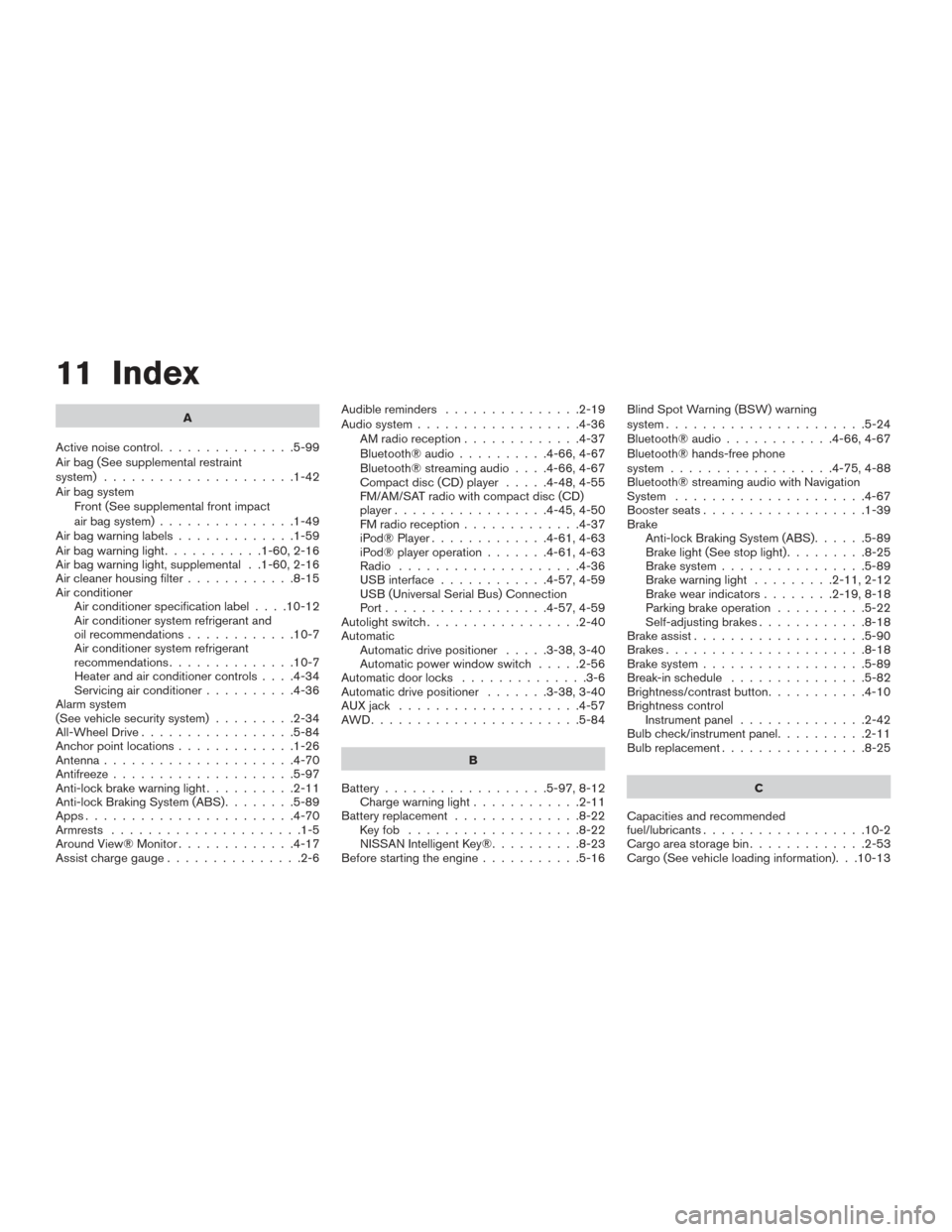
11 Index
A
Active noise control ...............5-99
Air bag (See supplemental restraint
system) .....................1-42
Air bag system Front (See supplemental front impact
air bag system) ...............1-49
Airbagwarninglabels.............1-59
Airbagwarninglight...........1-60,2-16
Air bag warning light, supplemental . .1-60, 2-16
Air cleaner housing filter ............8-15
Air conditioner Air conditioner specification label ....10-12
Air conditioner system refrigerant and
oil recommendations ............10-7
Air conditioner system refrigerant
recommendations ..............10-7
Heater and air conditioner controls ....4-34
Servicing air conditioner ..........4-36
Alarm system
(See vehicle security system) .........2-34
All-Wheel Drive .................5-84
Anchor point locations .............1-26
Antenna .....................4-70
Antifreeze ....................5-97
Anti-lock brake warning light ..........2-11
Anti-lock Braking System (ABS) ........5-89
Apps .......................4-70
Armrests .....................1-5
Around View® Monitor .............4-17
Assist charge gauge ...............2-6 Audible reminders
...............2-19
Audio system ..................4-36
AMradioreception.............4-37
Bluetooth®audio..........4-66,4-67
Bluetooth® streaming audio ....4-66,4-67
Compact disc (CD) player .....4-48,4-55
FM/AM/SAT radio with compact disc (CD)
player.................4-45,4-50
FMradioreception.............4-37
iPod® Player .............4-61,4-63
iPod® player operation .......4-61,4-63
Radio ....................4-36
USB interface ............4-57,4-59
USB (Universal Serial Bus) Connection
Port..................4-57,4-59
Autolight switch .................2-40
Automatic Automatic drive positioner .....3-38,3-40
Automatic power window switch .....2-56
Automatic door locks ..............3-6
Automatic drive positioner .......3-38,3-40
AUXjack ....................4-57
AWD.......................5-84
B
Battery ..................5-97,8-12
Chargewarninglight............2-11
Battery replacement ..............8-22
Keyfob ...................8-22
NISSAN Intelligent Key® ..........8-23
Before starting the engine ...........5-16 Blind Spot Warning (BSW) warning
system......................5-24
Bluetooth® audio
............4-66,4-67
Bluetooth® hands-free phone
system..................4-75,4-88
Bluetooth® streaming audio with Navigation
System .....................4-67
Boosterseats..................1-39
Brake Anti-lock Braking System (ABS) ......5-89
Brakelight(Seestoplight).........8-25
Brake system ................5-89
Brakewarninglight .........2-11,2-12
Brakewearindicators........2-19,8-18
Parking brake operation ..........5-22
Self-adjusting brakes ............8-18
Brake assist ...................5-90
Brakes ......................8-18
Brake system ..................5-89
Break-inschedule ...............5-82
Brightness/contrast button ...........4-10
Brightness control Instrument panel ..............
2
-42
Bulb check/instrument panel ..........2-11
Bulbreplacement................8-25
C
Capacities and recommended
fuel/lubricants ..................10-2
Cargoareastoragebin.............2-53
Cargo (See vehicle loading information). . .10-13
Page 514 of 520
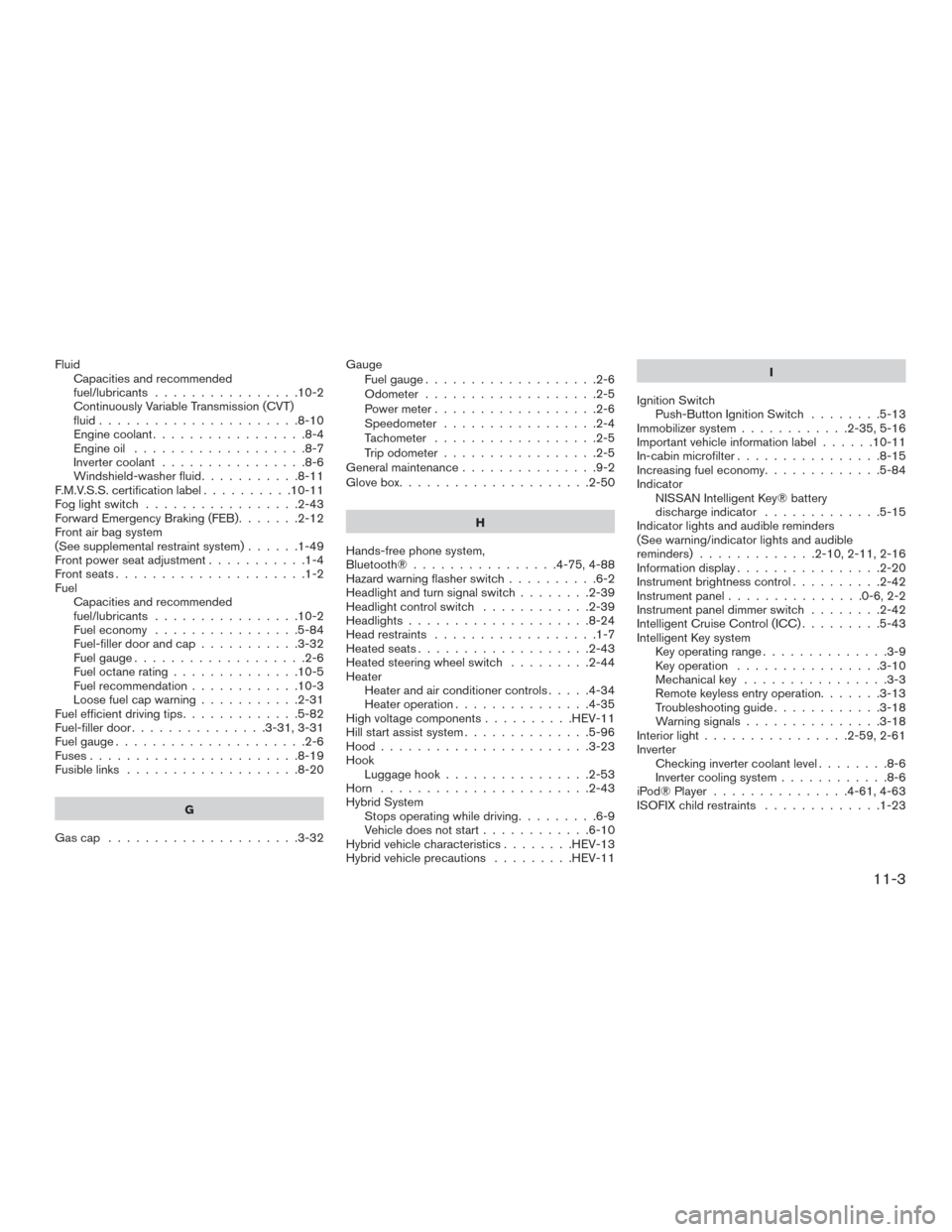
FluidCapacities and recommended
fuel/lubricants ................10-2
Continuously Variable Transmission (CVT)
fluid......................8-10
Engine coolant .................8-4
Engine oil ...................8-7
Invertercoolant ................8-6
Windshield-washerfluid...........8-11
F.M.V.S.S. certification label ..........10-11
Foglightswitch .................2-43
Forward Emergency Braking (FEB) .......2-12
Front air bag system
(See supplemental restraint system) ......1-49
Front power seat adjustment ...........1-4
Frontseats.....................1-2
Fuel Capacities and recommended
fuel/lubricants ................10-2
Fuel economy ................5-84
Fuel-filler door and cap ...........3-32
Fuel gauge ...................2-6
Fuel octane rating ..............10-5
Fuel recommendation ............10-3
Loose fuel cap warning ...........2-31
Fuel efficient driving tips .............5-82
Fuel-filler door ...............3-31,3-31
Fuel gauge .....................2-6
Fuses.......................8-19
Fusible links ...................8-20
G
Gascap .....................3-32 Gauge
Fuel gauge ...................2-6
Odometer ...................2-5
Power meter ..................2-6
Speedometer .................2-4
Tachometer ..................2-5
Trip odometer .................2-5
General maintenance ...............9-2
Glovebox.....................2-50
H
Hands-free phone system,
Bluetooth®................4-75,4-88
Hazard warning flasher switch ..........6-2
Headlight and turn signal switch ........2-39
Headlight control switch ............2-39
Headlights ....................8-24
Head restraints ..................1-7
Heated seats ...................2-43
Heated steering wheel switch .........2-44
Heater Heater and air conditioner controls .....4-34
Heater operation ...............4-35
High voltage components ..........HEV-11
Hill start assist system ..............5-96
Hood .......................3-23
Hook Luggage hook ................2-53
Horn .......................2-43
Hybrid System Stops operating while driving .........6-9
Vehicle does not start ............6-10
Hybrid vehicle characteristics ........HEV-13
Hybrid vehicle precautions .........HEV-11 I
Ignition Switch Push-Button Ignition Switch ........
5
-13
Immobilizer system ............2-35,5-16
Important vehicle information label ......10-11
In-cabin microfilter ................8-15
Increasing fuel economy .............5-84
Indicator NISSAN Intelligent Key® battery
discharge indicator .............5-15
Indicator lights and audible reminders
(See warning/indicator lights and audible
reminders).............2-10,2-11,2-16
Information display ................2-20
Instrument brightness control ..........2-42
Instrumentpanel...............0-6,2-2
Instrument panel dimmer switch ........2-42
Intelligent Cruise Control (ICC) .........5-43
Intelligent Key system Key operating range ..............3-9
Key operation ................3-10
Mechanical key ................3-3
Remote keyless entry operation.......3-13
Troubleshooting guide ............3-18
Warning signals ...............3-18
Interior light ................2-59,2-61
Inverter Checking inverter coolant level ........8-6
Inverter cooling system ............8-6
iPod®Player ............... 4-61, 4-63
ISOFIX child restraints .............1-23
11-3